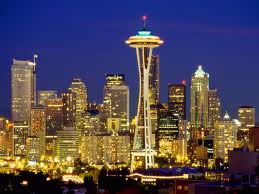Occasionally history seems to echo Men In Black.
Edwards: Why the big secret? People are smart.
Kay: A person is smart. People are dumb, panicky dangerous animals and you know it.
Of course, we tend to think that craziness is something that only far-off or long-ago peoples catch. Surely our neighbors in the modern world wouldn’t fall victim to collective delusions as easily as those in the past. Right?
 |
| Duh duh duh! |
Imagine my surprise, then, when I came across descriptions of an “epidemic” that took place right here in Seattle, a mere 57 years ago.
The case is commonly known as the “Seattle Windshield Pitting Epidemic.” It came on the heels of a media blitz regarding the recent hydrogen bomb tests in the Pacific at Eniwetok. And, like good news agencies everywhere, paper throughout the region were littered with dark headlines predicting doom and destruction. Everyone was convinced that nothing good could come of the tests.
 |
| Honestly, they had good reason to worry. |
 |
| Seriously, you have got to look at my windshield. |
Word spread quickly. Car owners covered their windshields as best they could with newspaper and kept their cars undercover if they were able. The mayor’s office quickly declared the manner not one for the police, deeming it to be something extraordinary rather than the work of vandals. They sprang into action- by telegraphing the governor and president asking for help.
 |
| Quickly! More windshields might be damaged! |
 |
| Some people blamed Gremlins. Honestly. |
Well, according to the research, none of them. The end report issued on June 10th stated that all of the reported damage was “overly emphasized” and “the result of normal driving conditions in which small objects strike the windshields of cars.”
 |
| Some small objects cause more damage than others. |
They could not find a single instance where the evidence contradicted that theory, and much that supported it. For instance, most of the dings appeared on the windshields of older cars. In used car lots the brand new cars were unpitted while the old ones were damaged. Pits also appeared more often on the front of cars rather than the back. And, as for the strange reports of people witnessing damage right before their eyes? Researchers were unable to verify any of the stories.
| The fact that these things on my car are perfectly normal is not very comforting. |
But, with all of the different theories, why did the public eventually decide on the H-bomb one? Of course the idea didn’t come out of thin air, the police themselves, as well as engineers and newspapers, cited nuclear fallout as a possible cause.
 |
| To be fair, no one was really sure what nuclear fallout really was. |
Part of the reason may very well be that blaming the damage on the testing acted as pressure release for many people in Seattle who had been very worried about the press regarding it in the months before. The idea was that something bad was bound to happen because of the testing, but once the windshield damage started appearing that meant that there wasn’t any reason to worry any more. The “bad thing” had surfaced and it wasn’t anything to worry about.
Their fear had taken concrete form and, thus, they could do something about it. The act of lining their windshields with paper or cardboard, telling their neighbors or even reporting to the police gave them something to do to combat the danger, even if it was only magical thinking.
 |
| Other versions of magical thinking. |
The ACR study goes on to mention that the very fact that the H-bomb was blamed is part of the reason why the epidemic was over so quickly. “In such a context it became meaningful for people to think that the pitting might have occurred in the space of a few hours or minutes on April 15th rather than over a longer period of time.”
So here we have a city that, for a few days in the middle of spring, imagined itself to be at the mercy of supercharged particles that somehow only affected glass windshields. To an outsider this seems like strange thinking indeed, but it wasn’t just the everyday people that were affected. The police department, the government, the military, engineers, the media, and scientists all got involved in the delusion. If this could happen even fifty years ago, who’s to say it couldn’t happen today?
And according to a 2001 article in the Los Angeles Times modern society may be even more prone to outbreaks of collective delusion than ever before due to the very nature of how quickly information travels these days and the tendency that mass media has to write about “frightening topics without putting them in the proper context.”
 |
| Seriously, just turn it on. Nothing good is on the news. |
So the next time you get a email filled with horrible information, or a text regarding the latest virus set to destroy your printer, or a news story about what kitchen appliance is going to kill you this week, take a long, deep breath, remember Seattle, and try to look at the situation from all angles before deciding who’s to blame.

Hello there! This blog post could not be written any better!
Reading through this post reminds me of my previous roommate!
He always kept talking about this. I’ll forward this article to him.
Fairly certain he’s going to have a very
good read. Thanks for sharing!